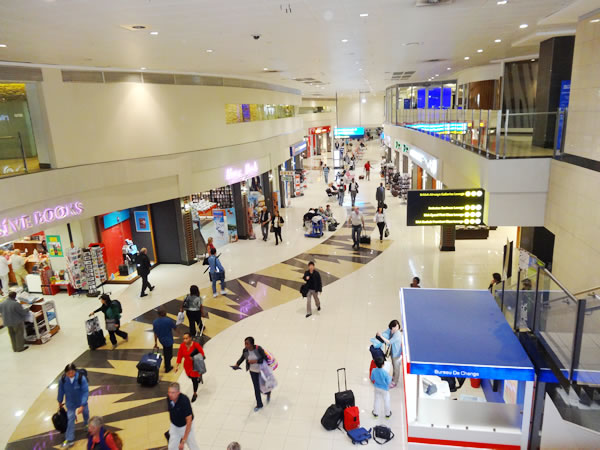 |
Bongani Maseko: ACSA is aiming to generate 70% of its income from non-aeronautical sources |
ZAMBIA. Commercial revenues featured heavily on the agenda at the 21 ACI African Region Annual Assembly, Conference & Exhibition, which concluded on Wednesday in Livingstone, Zambia.
The role of retail and commercial in enhancing airport incomes and also in improving the passenger experience was a key theme in a session chaired by The Moodie Report’s Dermot Davitt on Wednesday. There were strong presentations from Airports Company South Africa (ACSA) Acting Managing Director Bongani Maseko, Dufry Africa Deputy COO Thomas Galet and Tourvest Duty Free CEO Selwyn Grimsley, who covered the potential and challenges for commercial activities in Africa.
Maseko noted how ACSA is aiming to lift non-aeronautical revenues from 50% of income today to an ambitious 70%. Key to this drive are core retail (including duty free), advertising, car parking and property development.
 |
Selwyn Grimsley: Huge untapped opportunities remain for retailers |
Grimsley underlined the untapped potential of retail at many African airports, where despite the challenges of poor infrastructure, spends should and could be far higher in certain markets such as Nigeria or Kenya – especially given how robust these nationalities’ spends are inflight.
Galet noted the twin-track approach of Dufry in Africa, with strategies for small airports and larger (2 million-plus passengers) airports. He noted the importance of striking long-term deals with (preferably) contract exclusivity to allow international operators to invest in developing world standard retail environments.
 |
Thomas Galet: Dufry’s twin-track approach to Africa’s airports |
The commercial sector was addressed in several other sessions of the conference too.
A major challenge in the region is the fact that fewer than 20% of Africa’s 150-plus commercial airports have more than 1 million passengers per year, making the retail opportunity a limited one in most places. Within the continent, two countries and six airports contribute 40% of traffic, while 80% of the traffic is handled by eight countries.
But the potential remains strong to grow commercial’s share of revenues: the sector represents only a small percentage (less than 20%) of airport incomes in most locations, the exceptions being the major regional hubs, such as Johannesburg.
In one of the sessions on the funding of airport development, ACI Director of Economics Rafael Echevarne emphasised the often under-valued role of commercial. It was an area that the industry in Africa had yet to tap into, he said. “The potential of non-aeronautical revenues is huge, even at smaller airports,” he said.
In one of the most engaging sessions of the event, Federal Airports Authority of Nigeria CEO & Managing Director George Ureisi put the poor performance of non-aeronautical activities into context.
 |
George Ureisi: Commercial needs will help drive the next phase of Nigerian airports’ development, which will take in Lagos and the country’s other 21 airports |
“Our airports in Africa were mainly built in the 1960s and 1970s, with very little commercial infrastructure, when aeronautical was the only revenue stream. It’s true that regional airports have not emphasized commercial thinking but they have been constrained by infrastructure.
“But that is changing. We are upgrading all 22 Nigerian airports, and at Lagos there is a huge need for investment.
“We are enhancing our airports for better passenger service but also to expand the commercial offer. These can generate far bigger returns than they do today.
“That’s especially important in duty free because nobody buys more than the average Nigerian passenger. At London Heathrow the passengers to Lagos spend on average more than almost any other flight, and the figure is the highest at Atlanta too. It’s also about inflight retail: Delta (flying from Atlanta) used to only accept credit card payments, but because of the strong Nigerian spend, they had to change their policy and accept cash.”
 |
Many speakers underlined the enormous opportunites in Africa’s growing GDP and traffic |
Passenger growth in the region is broadly positive too. Although African passenger volumes fell by -3% year-on-year in 2011, this was mainly because of the sharp declines in North Africa following the Arab Spring. In sub-Saharan Africa, passenger numbers climbed by +8.1%, ACI Director General Angela Gittens noted, and was one of the fastest growing regions in the world.
Also, a number of African economies, led by Nigeria, are among the world’s fastest growing, ACI added. This is exciting, noted ACI, given the strong correlation between GDP growth and passenger traffic increases.
A key factor in the growth of air travel, said ACI Africa President Pascal Komla, is the rise of the region’s middle classes, who are now willing to travel by air. “Africa is still only a fraction of global air travel but its potential is huge. This has been a long abandoned region for aviation but not any more.”
We’ll bring you more from this event and on the potential for commercial activities at Africa’s airports soon.
 |
Johannesburg: The region’s biggest airport boasts a diverse and successful commercial offer – but many of Africa’s airports suffer from poor infrastructure, lack of space and limited ranges |





